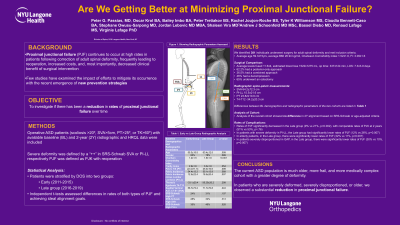Are We Getting Better at Minimizing Proximal Junctional Failure?
Friday, April 21, 2023


Peter G. Passias, MD
Spine Surgeon
NYU School of Medicine
New Canaan, CT, US
ePoster Presenter(s)
Introduction: Although proximal junctional failure continues to occur at high rates in patients following correction of adult spinal deformity, frequently leading to reoperation, increased costs, and, most importantly, decreased clinical benefit of surgical intervention, few studies have examined the impact of efforts to mitigate its occurrence with the recent emergence of new prevention strategies.
Methods: Operative ASD patients (scoliosis >20º, SVA>5cm, PT>25º, or TK>60º) with available baseline (BL) and 2-year (2Y) radiographic and HRQL data were included. Severe deformity was defined by a “++” in SRS-Schwab SVA or PI-LL respectively PJF was defined as PJK with reoperation. Patients were stratified by DOS into two groups: Early (2011-2015) and Late group (2016-2019). Independent t-tests assessed differences in rates of both types of PJF and achieving ideal alignment goals.
Results: 381 ASD patients. Differences between BL demographics and radiographic parameters of the two cohorts are listed in Table 1. Analysis of the overall cohort showed no difference in 2Y alignment based on SRS-Schwab or age-adjusted criteria. Rates of PJF significantly decreased in the Late group (9% vs 21%, p=0.002), with comparable rates of PJK at 2 years (51% vs 53%, p=.76). In patients with severe deformity in PI-LL, the Late group had significantly lower rates of PJF (12% vs 26%, p=0.007). In elderly patients, in the Late group, there were significantly lower rates of PJF (32% vs 11%, p=0.007) In patients severely disproportioned in GAP, in the Late group, there were significantly lower rates of PJF (30% vs 10%, p=0.007).
Conclusion : Patients are older, more frail, and more medically complex cohort with a greater degree of deformity. In patients who are severely deformed, severely disproportioned, or older, we observed a substantial reduction in PJF.
Methods: Operative ASD patients (scoliosis >20º, SVA>5cm, PT>25º, or TK>60º) with available baseline (BL) and 2-year (2Y) radiographic and HRQL data were included. Severe deformity was defined by a “++” in SRS-Schwab SVA or PI-LL respectively PJF was defined as PJK with reoperation. Patients were stratified by DOS into two groups: Early (2011-2015) and Late group (2016-2019). Independent t-tests assessed differences in rates of both types of PJF and achieving ideal alignment goals.
Results: 381 ASD patients. Differences between BL demographics and radiographic parameters of the two cohorts are listed in Table 1. Analysis of the overall cohort showed no difference in 2Y alignment based on SRS-Schwab or age-adjusted criteria. Rates of PJF significantly decreased in the Late group (9% vs 21%, p=0.002), with comparable rates of PJK at 2 years (51% vs 53%, p=.76). In patients with severe deformity in PI-LL, the Late group had significantly lower rates of PJF (12% vs 26%, p=0.007). In elderly patients, in the Late group, there were significantly lower rates of PJF (32% vs 11%, p=0.007) In patients severely disproportioned in GAP, in the Late group, there were significantly lower rates of PJF (30% vs 10%, p=0.007).
Conclusion : Patients are older, more frail, and more medically complex cohort with a greater degree of deformity. In patients who are severely deformed, severely disproportioned, or older, we observed a substantial reduction in PJF.
